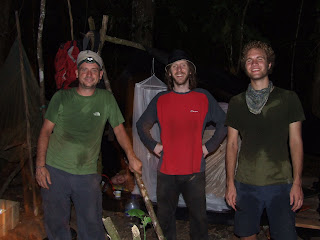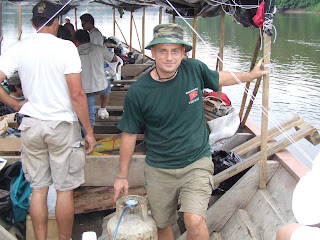Viaggio in barca da Puerto Morona (Ecuador) a San Lorenzo (Perù).
Racconto tratto dal diario di bordo.. ecco i miei scritti. LETTURA VIETATA AI PERBENISTI!!
- "Jacopo Simonetto
Sono qui sul Rio Morona con buoni amici, ufficialmente per uno studio sulle piante medicinali del luogo. In verità è un'opportunità di conoscere dal vivo quello che finora è stato visto da me solo in Tv o sui libri. Qui su una barca, dall'altra parte del mondo, appena entrati in territorio peruviano. Mi sento vivo e sono felice..."
Era solo il secondo giorno di viaggio, seduto sul bordo della barca mi arriva tra le mani il diario di bordo, capitolo "Historias de la primera noche". La notte avevamo dormito in una palafitta tradizionale di un villaggio lungo il Rio Morona. Sono ormai talmente abituato a dormire per terra e dovunque che un letto mi sembra un lusso da re.. non ci si può abituare altrettanto facilmente ad altri inconvenienti, e così scrissi questo sfogo:
- "Jacopo 2 marzo 2007
Mi son svegliato in piena notte in preda al prurito. Avevo il repellente e dormivo sotto la zanzariera. Il braccio è cmq tutto un bubbone e mi pongo del voltaren per alleviare il prurito. Se ho sognato qualcosa sicuramente erano insetti, tanti piccoli acari che mi ciucciavano il sangue, come piccoli vampiri o come certe donne. Con un po' di mentolo stamattina son riuscito a migliorare la situazione, ma un centinaio di punture sono cmq un bel problema. Se si estingueranno gli animali dell'Amazzonia, i primi spero siano mosquitos e company! Porca Miseria!!!"
Sì lo so, gli acari non sono insetti, ma aracnidi.. ma queste sono solo classificazioni umane, la foresta non distingue.. siamo tutti uguali, un giorno cacciatori, un'altro cacciati..
Altro sfogo.. Se mai un giorno andrete in America Latina e siete amanti della buona musica, quella moderna stile Londra e Berlino, preparatevi.. nei bus la notte devi sempre chiedere di spegnere la radio per poter dormire perchè si sente solo musica orrenda, in molte comunità indigene poi.. il loro mito è Bayron Caicedo, El Duro de l'Ecuador! Un tipo che canta canzoni assurde, tutte con lo stesso ritmo, e con balli improbabili! Poi il tema principale è sempre l'amore, nelle forme più svariate.. amori non corrisposti, tradimenti, amori impossibili, amori che finiscono, amori illeggittimi, amori di qua e di là e bla bla bla.. alcune canzoni sembrano quelle orrende napoletane che qualche mio camerata metteva allo stereo la domenica mattina in caserma.. non mi sono mai andate giù.. All'ennesimo racconto sdolcinevole, e dopo che qualcuno mi chiese di intitolare un capitolo del diario di bordo "L'Amor Por Ti", non ci ho più visto.. ecchecazzo, siamo nella foresta Amazzonica, mica ad un reality di Maria de Filippi, il marito di Costanzo per intenderci.. E così scrissi:
- "Jacopo:
L'amore è una sega mentale, alcuni lo confondono con l'affetto, ma insomma, basta con questa rottura di coglioni! Vivete la vita e fottetevi di questi stupidi nomi che diamo ai sentimenti!"
La seconda notte dormiamo a Shorayacocha, un villaggio diverso dal precedente.. mentre nell'altro tutti si nascosero al nostro arrivo (a momenti la figlia del capovillaggio ha paura di mangiarsi il Fansidar che le regalo.. cavolo, hai la malaria da un mese, e magnate sta pastiglia!), qui tutti ci accolgono curiosissimi.. un'esperienza stranissima! Guardano tutto quello che facciamo, siamo i primi europei per molti di loro, a parte i missionari evangelisti svizzeri. La notte dormiamo in una scuola, unica costruzione cementifera, inutilizzata, con alcuni banchi. Io Giorgio e Andreas (el Chico Norvuego) uniamo un 3 banchi, appendiamo la zanzariera, ed ecco pronto un confortevole letto grande la metà di noi e duro come piace alla nostra schiena. La notte escono vampiri dai pannelli in similcartongesso del soffitto, cadono a terra e corrono veloci come topi verso le pareti per poterso librare in volo.. mica ciucceranno il sangue a quelli che dormono a terra senza protezioni? Speriamo di no per loro.. cmq la notte rimane agitata per altri motivi. Avevo scritto questa parte in lingua veneta, giusto perchè in barca mi annoiavo un po', ho tradotto sennò chi ci capisce niente?
- "Jacopo: arrivati ad un villaggio di indios, tutti ci scrutano come i turisti con gli animali dello zoo. Lascerò ad altri l'onore di raccontare le belle cose del villaggio, io vi racconterò solo delle cose della notte. Mentre qualcuno sogna le belle indigene Shoraya, altri si ritrovano a dormire su un tavolo con la testa sbattuta al muro, tra Giorgio e Andreas. Una tipa ubriaca di drago, che i militari peruviani hanno portato per il viaggio, incomincia a fare dei gemiti un poco strani e noialtri cominciamo a ridere come vitelli. Alchè dei tori urlano così: Muuuuuuuììììììhh!! E noi giù a ridere ancora più forte, non riusciamo a fermarci.. lei geme, e i tori urlano! La scena si ripete varie volte.. Ride anche Andreas che all'inizio aveva protestato dicendo: "Italianos molestos".. La tipa pian piano si addormenta, il divertimento finisce e finalmente riusciamo ad addormentarci."
La foresta amazzonica è fantastica, un vero laboratorio di vita sotto tutte le forme. Vedere indios semiselvatici che mettono quel poco di spazzatura che producono tutta nella stesso posto per non sporcare la loro casa, e poi arrivare in luoghi come San Lorenzo, dove i Mestizos buttano tutti i rifiuti di una cittadina direttamente nel fiume, vedere alcuni "ecoturisti" in barca con noi lanciare la plastica nel fiume e al nostro rimprovero sentirsi rispondere che tanto tutto poi viene sepellito dal fango (poi i delfini rosa crepano perchè si strozzano con i sacchetti di plastica, ma cosa vuoi che sia, tanto sono solo delfini protetti internazionalmente..), a questo punto volano gli insulti e mi rendo conto di come sia l'ignoranza che ha distrutto anche la nostra bella Europa, di come sia l'ignoranza che permette che alcuni "Italiani" si adattino a vivere con montagne di spazzatura fuori casa senza prenderla e portarla davanti la casa della Jarvolino o di Bassolino.. ma cosa volete farci, è sempre un dovere degli altri tenere pulito, un dovere di CHI?? Buddha disse 2500 anni fa che il dolore sotto tutte le forme è frutto dell'ignoranza, in millenni l'uomo non è stato capace di fare tesoro di questo insegnamento.. sa solo piangere quando una frana gli cade addosso perchè prima ha tagliato tutti gli alberi, o perchè non ha più l'acqua potabile a forza di buttare i detersivi nei fiumi..
- "Jacopo 6 marzo 2007.
1) Qui sono onti! (sporchi). La foresta amazzonica ed il Rio Amazonas sono inquinati già dalla partenza, tutti buttano la spazzatura in acqua. In definitiva si inculino gli ecoturisti e i mestizos e tutti gli altri coglioni a cui piace un mondo sporco e malato. Del resto è molto semplice fare la raccolta o evitare di inquinare, poi qui non hanno un cazzo da fare e potrebbero benissimo impiegare un po' del loro tempo per fare pulizia, sistemare etc.. Tutto questo accade per colpa dell'ignoranza, per cui la gente che vive qui la si può definire ignorante all'n-esima potenza, non me ne vogliano male i perbenisti. A militare, a naja, l'ignoranza di norme scritte o sottintese non era una scusante, ma un'aggravante. Così dovrebbe essere sempre.
2) Ieri con Max siamo andati fino ad un villaggio di mestizos di nome Antenna 4, e mi son dovuto bere una coppa intera della bevanda che più odio: la Ciccia. (- in realtà ora mi sono abituato e se fatta bene non è niente male-) Che cesso di roba! Me ne sono andato un po' ubriaco e con la voglia di strozzare Max che a momenti mi costringeva a berne un'altra. Ora stiamo tornando verso Puerto Morona. In barca una scimmia, un koati, e a momenti il cucciolo di una lontra gigante dell'amazzonia. Per fortuna se ne è rimasta al fiume a nuotare."
Questa parte l'ho scritta in castigliano, traduco per ovvi motivi:
- "Jacopo 7/03/2007.
Sta qui con me una ragazza molto bella, intelligente e simpatica, che si chiama Lorenza. E' una sorta di orsetto, un cuchucho, o koati. E' più più intelligente delle scimmiette. Max è pazzo, parla molto e cucina come un tedesco. Cavolo capuccio con pomodoro e una sardina, spaghetti con pescato e.. limone!! Ieri vidi un delfino rosato, non speravo più di vederlo. Ora la barca sta tutta sporca di fango."
Leggere solo il mio diario di bordo, scritto tra un tuffo nel fiume e un'acquazzone tropicale, non dà molto l'idea di come fosse veramente la spedizione. Leggete anche le storie degli altri membri, sono scritte in spagnolo, anche se non lo conoscete si capisce lo stesso, più o meno.. Arriviamo al termine del viaggio.. anche se i miei scritti sono stati abbastanza critici, sappiate che navigare questo fiume e dormire nelle comunità indigene è un'esperienza impagabile! Il penultimo capitolo del diario di bordo consisteva nello scrivere consigli sui miglioramenti da apportare per le future spedizioni, che tralascio di scrivere. Trascrivo solo l'ultimo capitolo, dal titolo: "Que fue lo mas interesante?"
Lascerò questa parte nella versione originale in castigliano.
- "Jacopo:
a) Las chicas Shoraya
b) los maricones companero como Mario Franklin Lucio Aparicio
c) los otros companeros no maricones
d) nadar en el Rio
e) la chicha, la bevanda mas fea de mi vida despuès ayahuasca
f) aber escubierto que Maximiliano es completamente loco y irrecuperabile
g) San Lorenzo, la ciudad para nasconderse de la polizia italiana
h) el Capitàn, Jackie Chan, Victor (Sandokan), el Motorista otro Maximiliano
Jacopo Simonetto"
Le foto del viaggio in Ecuador e lungo il Rio Morona sono sul mio sito: www.jacopo13.blogspot.comCiao Italiani, se viaggiate in Ecuador contattatemi sull'indirizzo che c'è al mio sito, vi posso dare tante dritte e farvi risparmiare anche un po' di dinero.. Ciao!!!




















































